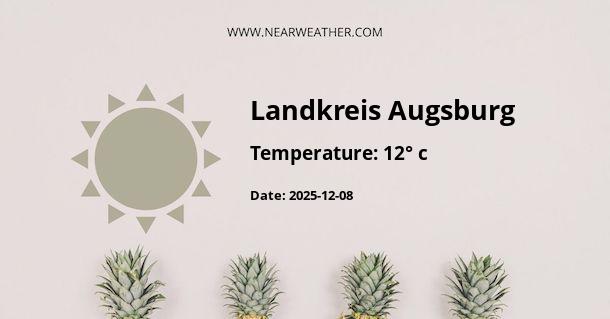Introduction to Landkreis Augsburg's Climate and Weather
Landkreis Augsburg, situated in the Southwest of Bavaria, Germany, is known for its continental climate, characterized by distinct seasons with variable weather patterns throughout the year. The region experiences warm summers, cold winters, and a moderate amount of precipitation that is fairly evenly dispersed over the months. Understanding the climate and weather of Landkreis Augsburg is essential for residents, farmers, tourists, and businesses alike.
Overview of Landkreis Augsburg's Climate
The climate in Landkreis Augsburg is classified as Cfb by the Köppen-Geiger system, which signifies a temperate oceanic climate with no significant dry season, a warm summer, and a near-even distribution of precipitation throughout the year. The region is influenced by Atlantic weather systems, which contributes to changeable weather patterns including occasional wet, windy conditions, especially during the transition between seasons.
Seasonal Climate and Weather Patterns
Spring
Spring in Landkreis Augsburg is a season of gradual warming and rejuvenation. It spans from late March to June. During this time, the average temperatures rise from around 5°C in March to pleasant highs of 20°C by the end of June. Precipitation is moderate with occasional showers, promoting the bloom of local flora.
Summer
Summer, lasting from June to September, is warm with long sunny days. The average temperature during the peak summer months of July and August can climb up to 24°C. However, the region can experience sporadic heatwaves with temperatures soaring above 30°C. Rainfall during summer often comes in the form of thunderstorms, which can be quite severe.
Autumn
Autumn, from September to December, is marked by a noticeable drop in temperatures and daylight hours. The average temperatures drop from around 19°C in September to a chilly 4°C by late November. This season is known for its beautiful foliage, albeit with an increased likelihood of fog and mist.
Winter
Winter, from December to March, is cold and sees fewer sunny days. Temperatures can range from an average high of 4°C during the day to below freezing at night. Snowfall is common, especially in the higher elevations, and can have a significant impact on transportation and outdoor activities.
Monthly Weather Statistics for Landkreis Augsburg
The following table provides a detailed breakdown of average monthly weather statistics for Landkreis Augsburg, including temperature ranges and precipitation levels.
| Month | Average High (°C) | Average Low (°C) | Precipitation (mm) | Days of Precipitation |
|---|---|---|---|---|
| January | 2 | -4 | 40 | 10 |
| February | 4 | -3 | 40 | 9 |
| March | 9 | 0 | 50 | 11 |
| April | 14 | 3 | 60 | 12 |
| May | 19 | 8 | 90 | 14 |
| June | 22 | 11 | 100 | 14 |
| July | 24 | 13 | 110 | 14 |
| August | 24 | 13 | 100 | 13 |
| September | 19 | 9 | 70 | 10 |
| October | 14 | 5 | 60 | 11 |
| November | 7 | 1 | 50 | 10 |
| December | 3 | -2 | 50 | 11 |
Extreme Weather and Climate Events
Like many regions, Landkreis Augsburg is not immune to extreme weather events and climate anomalies that can deviate from the average weather patterns. These events include:
- Heatwaves during the summer months, which can lead to increased stress on water resources and affect the health of vulnerable populations.
- Severe thunderstorms that can cause flooding, hail, and wind damage, particularly between June and August.
- Heavy snowfall and ice in winter, which can disrupt transportation and lead to dangerous driving conditions.
- Occasional drought conditions affecting agriculture and water supply during periods of below-average precipitation.
Climatic Influence on Agriculture and Industry
The climate in Landkreis Augsburg significantly impacts local agriculture, viticulture, and other industries. Adequate rainfall and warm summers are essential for the production of crops such as wheat, barley, and corn. The region's climate also supports the cultivation of specific grape varieties used in winemaking. The agricultural community must stay vigilant and adapt to climate variability to ensure sustainability and productivity.
Climate Change and Future Projections
Climate change is altering weather patterns globally and Landkreis Augsburg is no exception. Studies indicate that the region may experience:
- Increased average temperatures, leading to longer growing seasons.
- More frequent extreme weather events such as heatwaves and severe storms.
- Shifting precipitation patterns, which could lead to both droughts and increased risk of flooding.
Local and regional policymakers, as well as the community at large, are engaging in strategies to mitigate the impacts of climate change and adapt to emerging challenges.
Conclusion
In conclusion, Landkreis Augsburg's continental climate with its four distinct seasons offers a rich tapestry of weather patterns. While local residents and businesses appreciate and utilize this variability, they must also be prepared for extreme weather events and long-term change due to global climate shifts. It is essential that continuous observation, research, and adaptive management shape the region's response to climatic challenges, aiming to sustain its vibrant ecosystems, economy, and way of life for generations to come.
A - Landkreis Augsburg's Latitude is 48.352501 & Longitude is 10.710560.
A - Weather in Landkreis Augsburg is 6° today.
A - Climate Conditions in Landkreis Augsburg shows clear sky today.
A - Humidity in Landkreis Augsburg is 68% today.
A - Wind speed in Landkreis Augsburg is 9.25 km/h, flowing at 160° wind direction. today.
